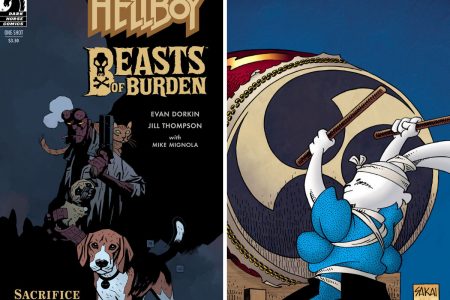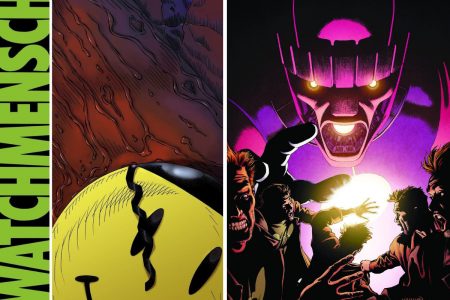Death: At Death’s Door
By Jill Thompson
During the Sandman: Season of Mists arc, Death finds her home invaded with the souls of the dead, so enlists the help of her sisters, Delirium and Despair, to find the missing souls. Delirium helps by throwing a party in Death’s home. This is enjoyably cute, but it is so cross-referenced and intertwined with the Sandman storyline that it makes you wonder what the point of the whole thing is. This is a fluffy nothingness of a story, with an American Manga style that gets on the nerves after a while and which doesn’t add anything to the original storyline.
Batman/Deathblow: After The Fire
By Brian Azzarello and Lee Bermejo
This book probably has testosterone implanted in the pages; the Azzarello dialogue and the Bermejo art is all about being manly, in a manly way. I felt I should be chewing glass while beer was pumped directly into my veins, in order to be at my most masculine. The story, involving government spooks and associated double-dealing shenanigans, plays to Azzarello’s strengths, while the design element of Bermejo, with his hard angles and muscular posturing (like a slicker Simon Bisley, but better), played well to the feel of the piece. I can barely remember it after reading it, but it was enjoyable fluff during it.
Road To Perdition
By Max Allan Collins and Richard Piers Rayner
I enjoyed the film, so I was curious to read the source material. The essence is the same, but the graphic novel is a much rawer, more-violent, more-masculine work. Collins put in a lot of research to get the period right, but not nearly as much as Rayner, who reportedly took 4 years to finish the book. It shows, as his art is detailed and exquisite, bringing the blood and reality to life, while still telling the story. It’s an odd sensation, reading this after the film, as the echoes of the adaptation linger, almost forcing you to compare the two. Sam Mendes made it more emotional, comparing the father–son relationships, whereas Collins is more interested in the brutal reality of the piece. Each stand up on their own, and both are equally rewarding, only in different ways.




